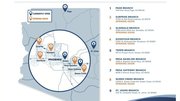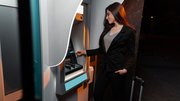News
Bank buy-in may give top-ups at ATM a boost
Nearly two years after the introduction of prepaid phone top-ups at ATMs in the United States, the top-ups service may be getting the boost that some industry insiders think it needs.
November 22, 2004
Nearly two years after the introduction of prepaid phone top-ups at ATMs in the United States, the top-ups service may be getting the boost that some industry insiders think it needs.
Check out bcgi's booth, |
James Anderson, vice president of Payment Services for Boston Communications Group (bcgi), a company that provides back-office services for wireless carriers, has long said that a big bank brand would help drive adoption of top-ups at the ATM.
"We need a bank to bring the branding power and ATM density we need to take (top-ups at the ATM) to the next stage," he said.
Anderson said bcgi was under-whelmed by the number of top-up transactions at ATMs managed byE*Trade Access and smaller ISOs it partnered with to offer the service in 2003.
Deciding that a bank brand was what it needed, bcgi established partnerships with ACI Worldwide and Mosaic Software, two transaction processing software providers used by a large number of financial institutions. A year after establishing interfaces between its back office and those processing platforms, bcgi has rolled out top-ups on some 4,000 ATMs owned by U.S. Bank, the sixth-largest bank in the country.
A little more than two weeks after launching the service, Anderson said transaction numbers at those machines are "exceeding our expectations" -despite a relative lack of marketing.
 |
Shown above is an advertisement that will be used to promote bcgi's "wireless wallet" service in the Seattle area. |
Anderson said the usage confirms bcgi's longstanding beliefs that "there is a latent demand for the service" and "many prepaid customers do have bank accounts" -beliefs increasingly echoed by consulting firms like the Yankee Group.
By the end of 2007, the Yankee Group predicts that prepaid and hybrid-prepaid plans will account for more than 25 percent of all wireless subscribers in the United States. Offering recharge at non-traditional locations like ATMs will become a necessity for carriers looking to attract and retain prepaid subscribers, Anderson said.
"It's exciting to see those transactions coming through and to know that customers -more customers than we anticipated -are taking advantage of the service," agreed Patty Henneke, U.S. Bank's vice president of ATM Banking.
Related stories New bcgi division to focus on ATM recharge, other payment methods Top-ups at ATM move into market |
The bcgi "wireless wallet" service is currently only promoted on the ATMs' welcome screens. Both Anderson and Henneke expect a spike in transaction numbers now that the two companies are launching radio and billboard promotions of the service in the Seattle area. U.S. Bank and bcgi split the cost of the ad campaign, which will continue for the next three months.
U.S. Bank, which currently offers postage stamps, prepaid phone cards and ticketing services on at least some of its ATMs, is "always looking" to offer new services, Henneke said. "We're interested in offering added convenience for our customers and for other banks' customers at our ATMs."
U.S. Bank hopes the service will attract new customers, particularly at sites like university campuses, Henneke said.
The bank is offering top-ups on both branch and non-branch ATMs in 24 states. Henneke said only U.S. Bank's oldest machines and a small number of ATMs in locations, where site owners preferred not to offer the service, were exempted.
Anderson said the ATM numbers compare favorably with distribution channels offered by retailers like 7-Eleven, which has 5,700 stores in 50 states.
None of the machines offering the service are on a Microsoft Windows-based platform. "We were not dependent on Windows to offer this service. The interface bcgi created to ACI made it simple," said Henneke, who noted that U.S. Bank is piloting a small number of Windows-based ATMs in Ohio and Arizona.
Though the newer OS is not a requirement, it will become even simpler to offer top-ups on Windows-based machines, Anderson said.
Users do not pay a convenience fee; the price for prepaid minutes is the same as if purchased at a retail store or directly from a carrier. Some non-U.S. Bank customers, however, may pay a foreign fee to their own institution for accessing the service at U.S. Bank ATMs.
U.S. Bank and bcgi split a commission paid by the wireless carriers, which is typically between 10 percent and 20 percent of the sale.
The process is "really simple," Henneke said. Prepaid subscribers swipe their cards and provide their mobile numbers to identify the prepaid accounts to be recharged and select the amount of their choice from the ATM screen.
The funds are made available in the subscriber's wireless account for immediate use or are delivered as a prepaid PIN for later redemption, depending on the wireless provider. The ATM prints a receipt with a record of the transaction and pertinent subscriber information.
Anderson said bcgi hopes more financial institutions and other deployers will follow U.S. Bank's lead. "A lot of people generally want to go second, so we're pretty optimistic."














